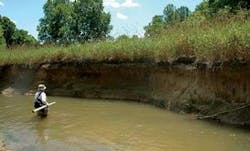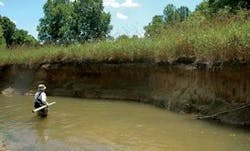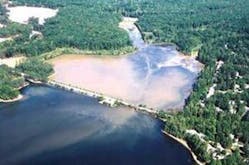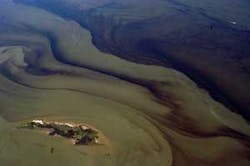by Joseph Battiata
The recognition of the impacts of urbanization on the health of our aquatic systems and watersheds dates back almost four decades. Since that time, significant goals to remedy the obvious industrial and sanitary wastewater discharges have been accomplished. Unfortunately, the continued decline of water quality has implicated a less obvious culprit — nonpoint source pollution.
In the Chesapeake Bay watershed, arguably one of the most highly scrutinized watersheds in the country, the evidence of the continued decline of water quality has focused attention on nonpoint source pollution associated with stormwater runoff from urban and suburban lands. Studies indicate that nonpoint source pollution associated with stormwater runoff from developed and developing urban and suburban lands represents the only increasing pollutant load impairing water quality in the Chesapeake Bay.1
Regulatory programs mandated at the national level are aimed at improving the quality of stormwater runoff. The biggest and most comprehensive is that of the Environmental Protection Agency's National Pollutant Discharge Elimination System (NPDES) Municipal Separate Storm Sewer System (MS4) permit program.2 As the name implies, this permit is required for municipal governments and other entities, such as universities and DOTs, which own and/or operate stormwater conveyance systems within populated areas.
In general this permit program holds municipalities responsible for identifying and addressing the pollutant loads in the stormwater runoff that discharges from their systems. The municipal governments or other regulated owners are required to implement a series of programmatic Minimum Control Measures,3 consisting of Best Management Practices applied on new development and within existing developed areas, which are targeted to achieve compliance with the water quality goals of the permit.
This is probably a review of old news for many stormwater professionals. On the other hand, public officials that are tracking the dollars being spent on implementing these stormwater programs are probably wondering about the return on this investment: Why do the projected costs of compliance with water quality standards continue to rise? And why, after targeting nonpoint source pollution for close to 20 years in the Chesapeake Bay Watershed, do we keep reading about how the cause of the continued decline of the quality of our rivers and streams, and the Bay itself, is urban runoff?
While these may be difficult questions, they must be answered. There needs to be an ongoing assessment of these programs, how they are implemented, and their relative benefit or success, with the goal of identifying which management practices work, which need to be improved, and which should be eliminated in order to ensure that these programs are effective and efficient.
The adaptive management process of developing a management plan, implementing the plan, and evaluating the effectiveness of that plan is an important element of achieving program goals to the “maximum extent practicable.” Revising or eliminating an underperforming or inefficient component is simply part of the dynamic and iterative process of implementing a stormwater program.
For example, the MS4 permits contain, among other measures, requirements for post–construction water quality controls on new and redevelopment projects. These requirements have traditionally consisted of a prescriptive set of BMP criteria that were developed through 20 years of BMP implementation and performance evaluations. However, there is a growing understanding that the increased volume and peak rate of runoff (e.g., stream channel erosion and loss of habitat from increased duration and velocity of flows) from existing developed and new developing lands are causing just as great, if not greater, impacts to receiving waters as the pollutant loads washing off the developed landscape.
Therefore, in an effort to address this program component and reduce the volume of stormwater runoff from new developing lands, there has been an aggressive trend towards incorporating Low Impact Development (LID) — also called Better Site Design (BSD) or Environmental Site Design (ESD) — into municipal stormwater management programs.
While the intent of these design strategies may be to influence the way land is developed so as to reduce impervious cover and therefore runoff volumes, the result has been to simply miniaturize BMPs. The evidence is in the development patterns of the last 10 to 20 years in the Chesapeake Bay watershed, where the rate of increase in impervious cover has been five times greater than that of the population, and the rate of increase in managed turf cover has been 10 times that of population.4 This reality is in stark contrast to the goal of reducing impervious cover.
In that regard, there are very promising stormwater program developments underway that may serve to effectively incentivize a culture of minimization and avoidance into the earliest stages of site design. Appropriately enough, the method is titled the Runoff Reduction Method (RRM)5, and is being developed through the Center for Watershed Protection in partnership with the Chesapeake Stormwater Network.
This methodology also incorporates the latest research on BMP design and volume reduction, and represents a significant step forward in the practice of stormwater management on new and redevelopment. To avoid repeating the mistakes of the past, there must be a focused effort to research these practices during the early phase of implementation in order to identify appropriate design and sizing criteria and ensure that the stormwater quality and quantity goals of the methodology are met.
While this represents a very positive development in the adaptive process, unfortunately the challenge of mitigating the impacts of existing developed lands remains. The expansion of impervious cover and the outdated methods of detaining peak discharges and releasing them over longer periods of time have conspired to cause significant levels of channel erosion and enlargement in second and third order streams. The channel erosion and pollutant loads resulting from existing developed lands will continue to be a growing problem, outweighing the incremental gains made through addressing these issues on new development.
Thus another example of the adaptive process is the successful implementation of the Henrico County, Virginia, Watershed Management Program (WMP).6 Henrico County is a growing municipality located in central Virginia with over 440 miles of streams with drainage areas of 100 acres or more. The WMP is based on a series of detailed stream assessments which were used to group the watersheds and subwatersheds as Preservation, Enhancement, Restoration, or Urban Management. The philosophy underpinning the program is to redirect the developers' investment from on–site controls within a highly urbanized watershed with an eroded stream channel, to restoring and stabilizing the stream channel. Similarly, in Preservation Watersheds, the philosophy is to focus developers' resources into on–site watershed–specific stormwater quality and quantity controls, including stream buffers and other practices, in an effort to protect a pristine stream system.
The process of quantifying those benefits during early program development and subsequent regulatory approval was not an easy task. Fortunately, the ability to assign a scientifically based credit to stream restoration and stabilization allowed the program to get started. The resulting implementation of stream restoration projects, the establishment and enhancement of riparian buffers, and the strategic use of structural BMPs have resulted in visible benefits. However, ongoing qualitative and quantitative assessments of the benefits will support an adaptive approach that continually updates and improves the program.
It should be noted that the stream surveys identified and eliminated hundreds of illicit discharges and illegal dumps, and generally revealed numerous opportunities to improve water quality and the overall health of the natural systems before any formal program implementation even occurred.
Drivers and Incentives
In the absence of a watershed program, what incentives can be created to encourage a property owner in an urban setting to retrofit an existing impervious area, such as a parking lot or other obvious source of urban nonpoint source pollution? The common approach is to require stormwater controls if and when the property redevelops. Unfortunately, the incentive to encourage redevelopment over “green field” development in most stormwater regulations is a reduction in the requirements for redevelopment projects.
While current redevelopment standards do allow properties to redevelop without the encumbrance of fitting a stormwater strategy into a maze of existing infrastructure, there are still opportunities to achieve significant water quality and quantity benefits through the implementation of ultra–urban and manufactured stormwater treatment technologies. Yes, there needs to be an incentive for redevelopment; but shouldn't those incentives be developed through tax credits, or other similar assessment credits, rather than discounting the protection of an environmental resource that is already stressed? Typical redevelopment projects are driven by prime location, not the offer of a “sweet stormwater deal.”
A potential driver of these opportunities may be nutrient offset or trading programs. Already being implemented in several states for both urban point and nonpoint sources, these programs offer potential market–based incentives for the implementation of urban retrofits. The critical piece of the equation is a high degree of confidence in the long–term performance of the practices, whether they are manufactured or traditional systems. Scientifically sound research into this very complex and dynamic issue thus becomes the foundation of such a program being effective and achieving water quality goals.
In time, either through the creative expansion of incentive–based offset or trading programs, or through the implementation of enforceable Total Maximum Daily Loads (TMDLs) for impaired streams, the stormwater retrofit of urban lands will become a significant element of compliance with municipal stormwater permits. When the MS4 owner is held accountable for stormwater discharges under a TMDL, there will be a renewed focus on ways to mitigate the impacts of existing urban areas.
One such case is the implementation of North Carolina's B. Everett Jordan Lake TMDL.7 The use of non–structural source control practices such as pet waste control, reduction in fertilizer application through education programs, rainwater harvesting, stream buffer restoration, removal of illicit discharges, street sweeping, etc., are identified as potential pollutant reduction practices for existing developed areas. The challenge now becomes assessing the individual benefit or failure of any one component within a very large watershed.
These are certainly not brand new practices or ideas; many have already been implemented elsewhere in one form or another. What is new is that these programs are being driven by the “stick” of a regulatory requirement and accountability that will demand results at a much faster pace than ever before. The “carrot” of economic benefits associated with clean water has not done the job. The momentum and resources needed to support innovative implementation and performance accountability of a regional effort — on the scale of the Chesapeake Bay watershed, for example — may in fact need the regulatory “stick” to kick start the effort.
About the Author
Joseph Battiata has 25 years of experience in stormwater management, water quality, erosion control, and other water resource issues in both the public and private sector. He lives in Richmond, VA, and currently works as a Senior Water Resources Engineer with Williamsburg Environmental Group Inc.
References
- Chesapeake Bay Commission. “Cost Effective Strategies for the Bay; Six Smart Investments for Nutrient and Sediment Reduction.” December 2004.
- EPA NPDES Program: http://cfpub2.epa.gov/npdes/index.cfm
- EPA NPDES Program Minimum Control Measures:http://cfpub2.epa.gov/npdes/stormwater/menuofbmps/index.cfm
- EPA Office of Inspector General Report No. 2007–P–00031, September 2007.
- Center for Watershed Protection. “Technical Memorandum – The Runoff Reduction Method.” April 2008. http://www.cwp.org
- Henrico County, Virginia. http://www.co.henrico.va.us/works/Background.htm
- Jordan Reservoir Water Supply Nutrient Strategy.http://h2o.enr.state.nc.us/nps/JordanNutrientStrategy.htm






